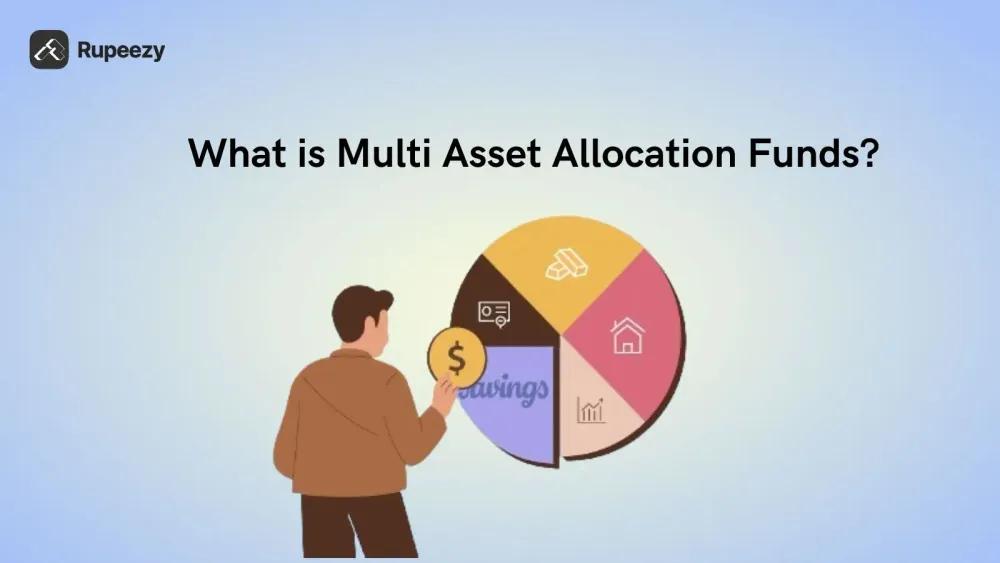What is Multi Asset Allocation Funds? 2025 Explained


00:00 / 00:00
The journey of an investor is often packed with the challenge of market volatility. The quest for an investment type that can provide both growth during bull runs while protecting during market corrections has led to the rise of one of the most prudent and balanced investment categories,w hich is the multi asset allocation fund.
This category of mutual funds is designed to simplify the complex task of asset allocation for the common investor, while offering a sophisticated, professionally managed, and diversified portfolio covered up in a single scheme. For anyone asking what is multi asset allocation fund is, the simplest answer is, it’s an all-in-one diversification solution. This article provides an understanding of multi asset allocation funds, while covering the regulatory requirements, key features, benefits, risks, and a guide on how to identify the best multi asset allocation fund. Keep reading to know more.
What is a Multi Asset Allocation Fund?
A multi asset allocation fund is an open-ended hybrid mutual fund scheme that is mandated to invest across at least three different asset classes. Unlike traditional hybrid funds, which primarily focus on equity and debt, these funds broaden their diversification horizon by including a third, and sometimes a fourth, distinct asset class. The primary objective is to generate long-term capital appreciation and income while managing overall portfolio volatility by leveraging the low correlation between different asset classes.
The core philosophy behind these funds is the time-tested investment principle that various asset classes (like equity, debt, gold, and real estate) do not perform in sync. When equities are under pressure, debt or gold might perform well, and vice versa. By maintaining a regulated minimum exposure to each asset class, the fund aims to deliver a smoother, more consistent return profile across different economic cycles than a fund solely focused on one asset class.
SEBI Guidelines on Multi Asset Allocation Funds
The Securities and Exchange Board of India (SEBI) has defined the mandatory asset allocation structure for a multi asset allocation fund. This clear definition ensures that the scheme remains true to its category name.
As per the latest regulatory guidelines, a multi asset allocation fund must invest a minimum of 10% of its total assets in each of the three asset classes.
The three mandatory asset classes include:
Equity and Equity-Related Instruments: For growth and capital appreciation.
Debt and Money Market Instruments: For stability, income generation, and capital preservation.
Commodities/Other Assets: This typically includes Gold or Silver ETFs, Exchange Traded Commodity Derivatives (ETCDs), Real Estate Investment Trusts (REITs), or Infrastructure Investment Trusts (InvITs), which can act as a hedge against inflation and economic uncertainty.
It is crucial to note that the maximum allocation limits are not strictly defined for all categories, but the minimum 10% in three distinct assets is the core feature. The fund manager has the flexibility to increase or decrease the allocation within the remaining corpus of the fund based on their market outlook, as long as the 10% minimum threshold for each of the three classes is maintained.
Key Features of Multi Asset Allocation Funds
Multi asset funds possess several features that make them a better choice for a diverse range of investors, such as:
Mandatory Triple Diversification: The regulatory requirement of investing at least 10% in three asset classes ensures diversification. This structured approach prevents overconcentration risk, which is a common pitfall when investors try to create a multi-asset portfolio manually.
Professional and Dynamic Management: The entire burden of asset allocation and periodic rebalancing is done by the fund manager. Based on their research and market views, the fund manager actively adjusts the asset mix. For example, if the equity market is overvalued, the manager might reduce the equity exposure (while staying above the required 10%) and increase allocation to debt or gold, thereby protecting the capital.
Automatic Rebalancing: A significant administrative and tax saving feature is the automatic rebalancing that occurs within the fund. Individual investors who manually rebalance their portfolio, like selling high performing assets to buy underperforming asset can incur capital gains tax on the sale. In a multi asset fund, the rebalancing is done within the scheme and does not trigger capital gains tax for the unit holder. This tax efficiency on rebalancing is a major draw.
Equity-Like or Non-Equity-Like Taxation: The tax treatment of a multi asset fund depends entirely on its gross exposure to equity and equity-related instruments.
Equity Taxation: If the scheme maintains a equity exposure of 65% or more of its total assets, it is taxed as an equity fund. This means Long Term Capital Gains (LTCG) crossing Rs 1.25 lakh per financial year are taxed at 12.5% after 12 months of holding, and Short Term Capital Gains (STCG) are taxed at 20% for instruments sold after July 23, 2024. Many multi-asset funds strategically maintain this 65% equity exposure, which is often through a combination of equity and arbitrage or hedging positions to provide the benefit of lower equity taxation.
Non-Equity or Debt Taxation: If the scheme's equity exposure is below 65%, it is taxed as a debt fund. This means LTCG is taxed at 12.5% (without indexation) after 24 months, and STCG is taxed at the investor's income tax slab rate. This tax consideration, driven by the fund manager’s allocation strategy, is a key point investors must check before investing.
Benefits of Multi Asset Allocation Funds
The popularity of these funds stems from a confluence of compelling benefits that address several practical challenges faced by investors.
Risk Mitigation & Smoother Returns: By combining assets with low correlation such as equity and gold, the fund reduces overall portfolio volatility. When one asset underperforms, another can cushion the impact, which can lead to a much smoother investment experience over full market cycles.
Simplification & Convenience: Investors can get exposure to diversified asset classes through a single investment vehicle. This eliminates the need to manage several different funds.
Professional Expertise: The fund is managed by seasoned professionals who use sophisticated models, research, and economic data to determine the optimal asset mix. This removes the emotional element and speculation from the investor’s asset allocation decisions.
Tax-Efficient Rebalancing: As explained above, the internal rebalancing by the fund manager does not incur any capital gains tax for the investor, a major advantage over individual manual rebalancing.
Inflation Hedge: The mandatory allocation to commodities like gold and silver provides a natural hedge against rising inflation, as these assets tend to perform well when conventional assets like equity and debt struggle due to inflationary pressures.
Discipline: Investing via a Systematic Investment Plan (SIP) in a multi asset fund enforces discipline and ensures that the investor systematically allocates capital across multiple asset classes over time.
Risks Associated with Multi Asset Allocation Funds
While designed for balanced risk, multi asset funds are not immune to market forces. Investors must be aware of the following risks:
Market Risk: Despite diversification, the fund’s returns are still linked to the performance of underlying securities. If all three asset classes which are equity, debt, and commodities, face a global or domestic downturn, the portfolio can suffer, though typically less severely than a pure equity fund.
Asset Allocation Risk: A portion of the fund's success depends on the fund manager's ability to take the right tactical calls on asset allocation. An incorrect macro-economic view or a poor judgment in shifting allocation can negatively impact performance.
Interest Rate Risk: The debt component of the fund is subject to interest rate fluctuations. When interest rates rise, the prices of existing bonds can typically fall, and vice versa.
Liquidity Risk: While its rare for a standard equity and debt portfolio, the inclusion of certain assets like specific REITs, InvITs, or illiquid derivatives could include some degree of liquidity risk, which can be challenging for the fund to sell large positions quickly without impacting prices.
Choosing the Right Fund
Simply knowing what is multi asset allocation fund isn't enough. As an investor you needs to make a framework that fits best for your risk profile. Since all funds must adhere to the 10% minimum rule, the difference in performance often comes down to the fund manager's active strategy, particularly regarding the allocation.
1. 65% Equity Threshold
The most critical factor for an Indian investor is the taxation status. You must check the scheme's current and intended long-term strategy in its Scheme Information Document or monthly fact sheet.
For Capital Growth & Aggressive Investors: You can take a look for funds that consistently maintain 65% equity exposure which can ensure equity taxation. These funds aim for higher growth by maximizing equity exposure while using debt or gold as a hedge.
For Income & Conservative Investors: You can take a look for funds that keep less than 65% equity exposure which can lead to debt taxation. While the returns might be lower without the indexation benefit and currently STCG is charged at slab rate. However, there is a benefit that can be advantageous for investors in the highest tax bracket. If they keep invested for more than 24 months (depends on tax slab) it turns out to be LTCG taxed at 12.5% rather than the slab rate.
2. Type of Third Asset Class
While the guideline says at least three asset classes, many funds use their flexibility to choose different combinations for their third and fourth asset classes.
Inflation Hedge Focus: Funds with a larger and consistent allocation to gold ETFs are typically better hedges against inflation and global economic crises.
Infrastructure or Real Estate Focus: Funds allocating to REITs and InvITs offer exposure to Indian infrastructure or real estate, which can perform well during a domestic economic boom but may be less liquid than gold ETFs.
An investor should select a fund whose core asset allocation strategy aligns with their personal risk profile and financial goals or consult a financial advisor to make better informed decisions. Below is the table which shows the asset allocations aligning with the taxations rule.
Asset Class | Equity Oriented | Other than Equity oriented |
Equity & equity related securities | 65-80% | 35-80% |
Debt | 10-25% | 10-55% |
Gold/Silver & Other commodity | 10-25% | 10-55% |
International Equities/Debt | 0-15% | 0-45% |
REITs & Invits | 0-10% | 0-10% |
Source: DSP Mutual Fund
The Core of Portfolio Theory
The true value of a multi asset allocation fund lies in its sophisticated application of modern portfolio theory, a concept often too complex for individual implementation. The investor should understand this fundamental principle to fully appreciate the fund category.
Correlation, Volatility, and the Efficient Frontier
In financial terms, different assets have different correlations. Correlation measures how two assets move in relation to each other.
Equity and Debt often have a low positive correlation or sometimes a negative correlation like when interest rates fall, equity might rise, but debt prices rise significantly.
Equity and Gold often have a negative correlation: gold is typically a safe-haven asset, rising during times of high market volatility or geopolitical uncertainty based on historical performances.
A multi asset allocation fund combines these negatively or low-correlated assets. The goal is not necessarily to maximise returns, but to achieve the highest possible return for a given level of risk. This ideal portfolio combination is what investment theorists call the Efficient Frontier. By managing the asset mix, the fund attempts to keep your portfolio close to this frontier.
For Investor: When you invest in a multi asset fund, you are essentially paying for a fund manager to constantly re-engineer your portfolio to reduce its volatility while keeping its growth potential high. For an investor who is poor at timing the market but excellent at staying in the market, this professional, volatility-reducing mechanism is invaluable.
Top Multi Asset Allocation Funds in India
The performance of multi asset allocation funds is best evaluated over longer periods, such as 3-year or 5-year Compounded Annual Growth Rate (CAGR), as they are expected to perform across market cycles. The following list presents some of the top-performing schemes.
Serial No. | Fund Name | 3-Year CAGR (Approx.) |
1 | 21.54% | |
2 | 20.73% | |
3 | 20.63% | |
4 | 20.26% | |
5 | 17.57% | |
6 | 16.06% | |
7 | 15.21% | |
8 | 13.87% | |
9 | - | |
10 | - |
Disclaimer: The above figures are taken from Rupeezy and meant for illustrative and informational purposes based on recent market data. Actual returns can vary daily. Investors must check the latest factsheets before making any investment decision. The above 2 funds started in the year 2023, so the data is not available. Past performance is not indicative of future returns, and investors should consult a financial advisor.
How to Invest in a Multi Asset Allocation Fund
Investing in a multi asset allocation fund is a straightforward process, similar to investing in any other mutual fund.
Determine Your Risk Profile: Even though these funds are balanced, they are still subject to market risk. Determine if you are a moderate or moderate-to-aggressive investor.
Define Your Investment Horizon: Multi asset funds are best suited for long-term goals which is usually 3 or 5 years or more to allow the diversification benefit to even out returns across multiple market cycles.
Set Your Goal: Align the investment with a specific financial goal such as retirement, child's education, buying a house or any other goals which aligns to you.
Analyse the Fund’s Mandate: Check the Scheme Information Document (SID) or fund factsheet for the fund's intended asset mix and its taxation status.
Review Fund Manager's Track Record: Look at the fund's long-term performance especially for 3, 5, and 10 years compared to its benchmark and peers. Consistency in risk-adjusted returns such as Sharpe Ratio is more important than actual returns.
Check the Expense Ratio: You should look at the lower Expense Ratio coupled with above parameters, which can be a factor in improving your net returns.
How to Invest in Multi Asset Allocation Fund?
You can invest in Multi Asset Allocation Fund through an Asset Management Company (AMC) or invest through a prominent brokerage companies like Rupeezy. Here are the steps that can help you to invest in a Multi Asset Allocation Fund:
Begin by downloading a Rupeezy App from the Google Play Store or Apple App Store. You'll then need to complete the Know Your Customer (KYC) verification to finalize your new investment account.
Navigate to the Explore or Discovery area of the app to view the various fund types available, such as Equity, Debt and Hybrid, or use the search bar to find a specific fund by name.
Carefully review the funds and narrow down your interest to the specific mutual funds you plan to invest in.
Evaluate your chosen funds by comparing crucial metrics like their historical returns, expense ratios, and other relevant data. This analysis is key to selecting a fund that matches your financial objectives, aiming for strong growth at a reasonable cost.
Execute your purchase using either
Systematic Investment Plan (SIP): For long term investors, SIP is the better way to benefit from rupee cost averaging and brings consistent discipline in investing.
Lump Sum: This is suitable if you have a large corpus and the market is currently undervalued, or if you plan to invest the lump sum over a few months via a Systematic Transfer Plan (STP) into the multi asset fund from a liquid fund.
After selecting the SIP or Lumpsum, your unit purchase request will be sent to the respective AMC. Remember to routinely check and adjust your portfolio as needed. Consult a financial advisor for more clarity.
Conclusion
The multi asset allocation fund is a cornerstone product for the modern investor seeking simplicity, diversification, and a disciplined approach to wealth creation. By leveraging the principles of portfolio theory and the mandate of investing in at least three asset classes, equities for growth, debt for stability, and commodities like gold or silver for hedging.
These funds offer a blend of risk mitigation and long-term return potential. For a new investor, it can serve as an excellent core portfolio holding, while for a seasoned investor, it provides a tax-efficient and professionally rebalanced hybrid solution.
When choosing the best multi asset allocation fund, always remember to look beyond just the 3-year returns; scrutinize the fund’s underlying strategy for asset allocation and its tax implications to ensure it aligns perfectly with your financial roadmap. Consult a financial advisor before investing for more clarity.
FAQs on Multi Asset Allocation Funds
Q1) What is a Multi Asset Allocation Fund?
A Multi Asset Allocation Fund is a type of mutual fund that invests in a mandatory minimum of three distinct asset classes, such as equity, debt, and commodity or other assets, with at least 10% in each.
Q2) What is the main benefit of investing in these funds?
The main benefit is diversification across assets with low correlation, which helps to mitigate risk and potentially provide more stable, risk-adjusted returns across different market cycles.
Q3) How do fund managers handle the assets?
Fund managers actively rebalance the portfolio by shifting allocations between assets based on market conditions, valuations, and their economic outlook.
Q4) Who is the ideal investor for Multi Asset Allocation Funds?
These funds are ideal for beginners and long-term investors seeking a simplified, professionally managed portfolio that balances the potential for growth with lower volatility. Consult a financial advisor before investing.
Q5) Are Multi Asset Allocation Funds considered less risky than pure equity funds?
Yes, they are generally considered less risky than pure equity funds because losses in one asset class can often be offset by the stability or gains in another, thereby reducing overall portfolio volatility.
The content on this blog is for educational purposes only and should not be considered investment advice. While we strive for accuracy, some information may contain errors or delays in updates.
Mentions of stocks or investment products are solely for informational purposes and do not constitute recommendations. Investors should conduct their own research before making any decisions.
Investing in financial markets are subject to market risks, and past performance does not guarantee future results. It is advisable to consult a qualified financial professional, review official documents, and verify information independently before making investment decisions.

All Category









